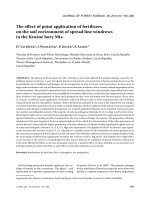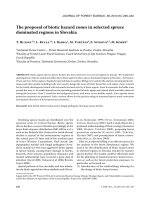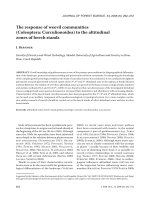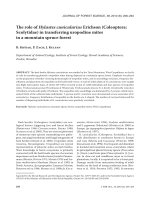Báo cáo lâm nghiệp: "The influence of acid mist upon transpiration, shoot water potential and pressure—volume curves of red spruce seedlings" pot
Bạn đang xem bản rút gọn của tài liệu. Xem và tải ngay bản đầy đủ của tài liệu tại đây (169.97 KB, 4 trang )
The
influence
of
acid
mist
upon
transpiration,
shoot
water
potential
and
pressure—volume
curves
of
red
spruce
seedlings
D. Eamus
I. Leith
D.
Fowler
Institute
of
Terrestrial
Ecology,
Bush
Estate,
Penicuik,
EH
26
OOB,
Scotland,
U.K.
Introduction
Widespread
forest
decline
has
been
docu-
mented
in
Europe
and
NE-U.S.A.
(John-
son,
1987;
Woodman,
1987).
This
decline
increases
with
increasing
altitude
(Mc-
Laughlin,
1985).
One
hypothesis
to
ex-
plain
the
decline
and
its
altitude
depen-
dence
is
that
excessive
proton
input
has
a
deleterious
effect
upon
tree
growth.
Acid
input
to
the
foliage
and
soil
via
wet
and
dry
deposition
may
be
a
major
factor
in
causing
decline
directly
or
indirectly
by
predisposing
the
tree
to
additional
biotic
and/or
abiotic
stress
factors.
.
The
maintenance
of
a
favorable
water
status
is
a
priority
for
continued
growth
and
survival,
and
many
of
the
symptoms
associated
with
forest
decline
(crown
thin-
ning,
root
necroses)
may
be
expected
to
influence
plant
water
status.
This
paper
presents
some
of
the
results
of
a
detailed
study
of
the
influence
of
acid mist
on
the
water
relations
of
red
spruce
seedlings.
Materials
and
Methods
Red
spruce
seeds
were
germinated
and
grown
for
16
mo
in
a
greenhouse
maintained
at
16-20°C.
On
16/7/87
100
seedlings
were
placed
inside
each
of
8
open
top
chambers
(OTCs)
at
a
site
in
Scotland,
U.K.
(55°50’N;
2°13’W;
200
m
altitude).
Four
different
pH
treat-
ments
(pH
2.5, 3.0,
4.0
and
5.0)
with
simulated
acid
mist
were
supplied
using
dilutions
of
an
equimolar
solution
of
(NH
4)Z
SO
Q
and
HN0
3-
Each
chamber
received
twice
weekly
sprays
with
an
equivalent
of
2
mm
precipitation
per
spray.
Spraying
commenced
on
24/7/87
and
continued
until
20112187.
The
following
measurements
were
made:
1)
shoot
water
potential
was
determined
at
09:00
h
on
23/10/87
using
a
portable
Scholander
pressure
bomb
(Hellkvist
et
al.,
1974).
Eight
replicate
branches
from
pH
? 5,
3.0,
4.0
and
5.0
treated
trees
were
measured.
2)
Day
and
night
transpiration
rates
were
determined
on
16/11/87
for
10
entire
seedlings,
of
pH
2.5
and
pH
5.0
treatments
and
10
attached
shoots
enclosed
in
a
cuvette.
3)
Eight
replicate
shoots
(rehydrated
overnight
as
attached
branches)
from
pH
2.5,
3.0
and
5.0
treated
seedlings
were
subjected
to
pressure-volume
analysis
(Kim
and
Lee-Sta-
delmann,
1984;
Stadelmann,
1984).
Results
Fig.
1
shows
that
branch
water
potential
(’Pw)
decreased
from
!.07
to
-1.2
MPa
as
treatment
pH
decreased
from
5.0
to
? 5.
Day
and
night
transpiration
rates
were
1.19 ± 0.06
mmol
’
s-
1
.tree-
1
(day)
and
0.54 ± 0.06
mmol
’
s-
1
.tree-
1
(night)
for
whole
trees
treated
with
pH
2.5
mist,
and
1.5 ± 0.14
mmol
’
s-
1
.tree-
1
(day)
and
0.68
± 0.09
mmol
’
s-
1
.tree-
1
(night)
for
pH
5.0
treated
trees.
Night:day
ratio
was
0.45
for
both.
The
slightly
greater
values
for
pH
5.0
treated
trees
per
tree
was
due
to
the
slightly
larger
pH
5.0
trees.
However,
day
and
night
transpiration
rates
for
branches,
expressed
on a
unit
area
basis,
did
not
differ
significantly
(pH
2.5:
0.23 ±
0.04
mmol-m-
2
-s
7l
(day),
0.099 ± 0.006
mmol-m-
2
-s-
1
(night);
pH
5.0:
0.22 ± 0.03
mmol-m-
2
-s-
1
(day),
0.015
mmol!m-2!s-!
(night)).
Table
I is
a
summary
of
the
data
derived
from
pressure-volume
curves.
Maximum
turgor
decreased
from
2.35
to
1.3
MPa
as
treatment
pH
decreased.
The
relative
water
content
(RINC)
associated
with
zero
turgor
( Yp=0)
and
the
maximum
bulk
volu-
metric
elastic
modulus
(
Ev
)
decreased
as
treatment
pH
decreased.
Solute
potential
(’
1
’11’)
at
zero
turgor
decreased
with
in-
creasing
treatment
pH.
Fig.
2
shows
changes
in
ev
with
turgor
(top)
and
RWC
(bottom)
for
pH
2.5,
3.0
and
pH
5.0
treated
branches. -,
increased
linearly
with
turgor
and
increased
curvili-
nearly
with
RWC.
pH
5.0
treated
trees
maintained
the
largest
Ey
at
all
turgors,
pH
2.5
treated
trees
maintained
the
smallest,
with
pH
3.0
intermediate
between
the
two.
For
all
RWCs
greater
than
90%,
this
trend
was
observed,
whilst
at
RWCs
less
than
90%
3
crossover
points
in
the
data
oc-
curred.
Discussion
and
Conclusion
The
developms!nt
of
water
stress
is
char-
acterized
by
a
decline
in
’I
’
w’
In
this
study,
as
treatment
pH
decreased,
branch
*!,
decreased,
revealing
a
mild
but
significant
water
stress.
Water
stress
occurs
when
the
rate
of
water
loss
exceeds
the
rate
of
uptake.
It
was
clear
that
the
rates
of
day
and
night
transpiration
did
not
differ
be-
tween
treatments.
From
needle
drying
curves
(data
not
shown),
cuticular
resis-
tance
did
not
differ
between
treatments.
This
result
is
in
contradiction
to
those
of
several
investigators
who
noted
a
signifi-
cant
effect
of
acid
rain/mist
upon
cuticle
structure
and/or
resistance.
The
lack
of
apparent
effect
in
the
present
study
may
be
due
to
an
efficient
repair
mechanism
or
because
changes
in
structure
can
occur
without
concomitant
changes
in
cuticular
resistance.
It
is
suggested
that
uptake
and/or
supply
of
water
may
be
impaired
in
the
roots
or
acid-treated
seedlings.
Pres-
sure-volume
analysis
revealed
significant
effects
of
the
acid
mist.
Maximum
turgor
(’Fp,
max)
decreased
with
decreasing
treatment
pH.
This
decreased
ty
p,
max
reflects
a
reduction
in
solute
accumula-
tion.
A
significant
reduction
in
solute
potential
associated
with
zero
turgor
(Table
I)
was
also
observed
as
treatment
pH
increased,
further
reflecting
a
de-
crease
in
solute
accumulation
with
decreased
pH
of
the
treatment
mist Tur-
gor
(W
p)
was
maintained
to
lower
RI!VCs
at
pH
2.5
than
pH
3.0
treated
branches.
This
can
result
from
either
increased
solute
accumulation
or
reduced
-,.
The
former
did
not
occur;
the
latter
did
(Table
I).
A
reduction
in
Ey
indicates
a
more
elastic
cell
wall,
possibly
the
result
of
the
acidification
of
the
apoplast
leading
to
proton-induced
cell
wall
loosening
(Davies,
1973).
References
Davies
P.J.
(1973)
Current
theories
on
the
mode
of
action
of
auxin.
Bot.
Rev.
39, 139-171
Hellkvist
J.,
Richards
G.P.
&
Jarvis
P.G.
(1974)
Vertical
gradients
of
water
potential
and
tissue
water
relations
in
Sitka
spruce
trees
measured
with
the
pressure
chamber.
J.
Appl.
Ecol.
11,
637-667
Johnson
A.H.
(1987)
Deterioration
of
red
spruce
in
the
northern
Appalachian
mountain.
In:
Effects
of
Atmospheric
Pollutants
on
Forests,
VVetlands
and
Ac
f
ricultural
Ecosystems,
(Hutch-
inson
T.C.
&
Meema
K.M.,
eds.),
NATO
ASI
Series,
Springer-’Verlag,
Berlin,
pp.
83-99
Kim
J.M.
&
Lee-3tadelmann
O.Y.
(1984)
Water
relations
and
cell
wall
elastic
quantities
in
Phaseolus
vulgaris
leaves.
J.
Exp.
Bot.
35,
841 -
858
McLaughlin
S.B.
(1985)
Effects
of
air
pollution
on
forests.
A
criiical
review.
J.
Air
Pollut.
Con-
trol Assoc. 35,
5!;
2-532
Stadelmann
E.J.
(1984)
The
derivation
of
the
cell
wall
elasticity
function
from
the
cell
turgor
potential
J.
Exp.
Bot.
35,
859-868
Woodman
J.N.
(1987)
Pollution
induced
injury
in
North
American
forests:
facts
and
suspicions.
Tree
Physiol.
3,
H
5









